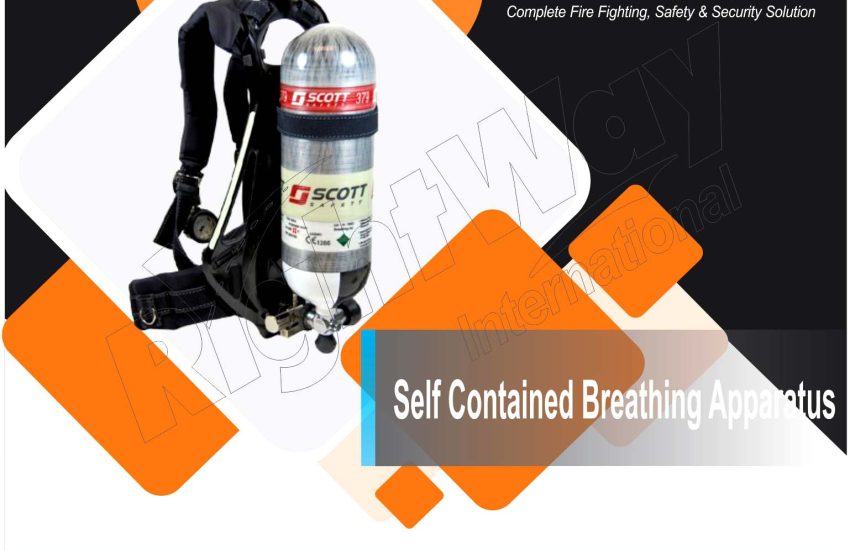Self-Contained Breathing Apparatus (SCBA) provides breathable air in environments that are immediately dangerous to life or health (IDLH). Commonly used by firefighters, emergency responders, and industrial workers, SCBAs are vital for survival in smoke-filled, oxygen-deficient, or toxic environments.
1. Purpose and Primary Use of Self-Contained Breathing Apparatus
SCBAs ensure respiratory protection when air quality is compromised. Professionals who rely on SCBAs include:
- Firefighters – for navigating smoke and heat
- Industrial workers – in confined or hazardous spaces
- Emergency medical personnel – in chemically contaminated scenes
- Rescue teams – during structural collapse, gas leaks, or toxic spills
Because these environments can change rapidly, having a dependable air supply is critical to safety.
2. Key Components of an SCBA
Each SCBA includes the following main parts:
- Air Cylinder: Stores compressed air at high pressure, typically between 2,200 and 4,500 psi. Manufacturers use aluminum, steel, or composite materials to keep the unit durable yet lightweight.
- Regulator: Reduces high-pressure air from the cylinder to a safe, breathable level. It automatically adjusts airflow based on the user’s demand.
- Facepiece (Mask): Covers the entire face and seals tightly to prevent contaminated air from leaking in. A built-in visor ensures visibility even in smoky or dark conditions.
- Harness and Backplate: Holds the air cylinder securely on the user’s back. The harness includes adjustable shoulder and waist straps for stability and comfort.
- Alarm System: Low-air alarms (usually audible and/or vibrating) warn the user when the air supply drops to a critical level, prompting immediate evacuation.
3. SCBA Operation
Pre-Use Inspection
Before putting on the SCBA, users should:
- Inspect the harness, cylinder, and facepiece for damage
- Confirm that the air cylinder is full
- Check that all valves and regulators function correctly
Donning the SCBA
To wear the SCBA:
- Position the harness on the back and tighten the straps
- Put on the facepiece and verify a secure seal
- Activate the regulator to begin air flow
During Use
While operating in the hazardous area, users monitor air pressure using a gauge or heads-up display. Breathing draws air through the regulator as needed, conserving supply.
Doffing the Equipment
Once clear of danger:
- Remove the facepiece and harness
- Check the remaining air pressure
- Clean and inspect the equipment before refilling the cylinder and storing the unit
4. Types of SCBA Systems
There are two main SCBA designs:
- Open-Circuit SCBA: The most common type. Users exhale air into the environment. Used widely by fire services and industrial safety teams.
- Closed-Circuit SCBA (Rebreather): Filters and recirculates exhaled air, removing CO₂ and replenishing oxygen. Ideal for longer-duration missions like mine rescue or submarine escape.
5. Maintenance and Inspection of Self-Contained Breathing Apparatus
Regular maintenance is vital to ensure SCBA reliability:
- Visual Checks: Look for signs of wear or damage on the harness, hoses, and mask
- Functional Testing: Test the regulator, alarm, and valve operation
- Air Cylinder Management: Refill cylinders after use and inspect for hydrostatic testing compliance
Most manufacturers require scheduled servicing and annual professional inspections, often dictated by NFPA or OSHA standards.
6. Safety Guidelines and Training of Self-Contained Breathing Apparatus
While SCBAs are life-saving tools, users must understand how to operate them safely:
- Fit Testing: Ensures the mask seals properly for each individual
- Hands-On Training: Includes donning/doffing drills, emergency procedures, and troubleshooting
- Air Management: Teaches users how to monitor consumption and plan for timely exit
Consistent practice helps users react confidently under stress.
7. Regulatory Standards of Self-Contained Breathing Apparatus
SCBAs must comply with specific standards to ensure safety and performance:
- NFPA 1981: Specifies design and performance for SCBAs used by firefighters
- NIOSH Certification: Ensures units meet U.S. health and safety regulations
- OSHA Requirements: Mandate usage protocols and training for workers in IDLH conditions
Globally, other bodies like the European Committee for Standardization (CEN) set similar performance benchmarks.
Conclusion
Self-Contained Breathing Apparatus are essential for working safely in environments where breathable air is unavailable or contaminated. By providing a dependable air supply, these devices allow trained professionals to perform critical tasks during fires, rescues, and hazardous material incidents. Regular maintenance, proper use, and adherence to safety standards ensure that SCBAs deliver protection exactly when it’s needed most.


